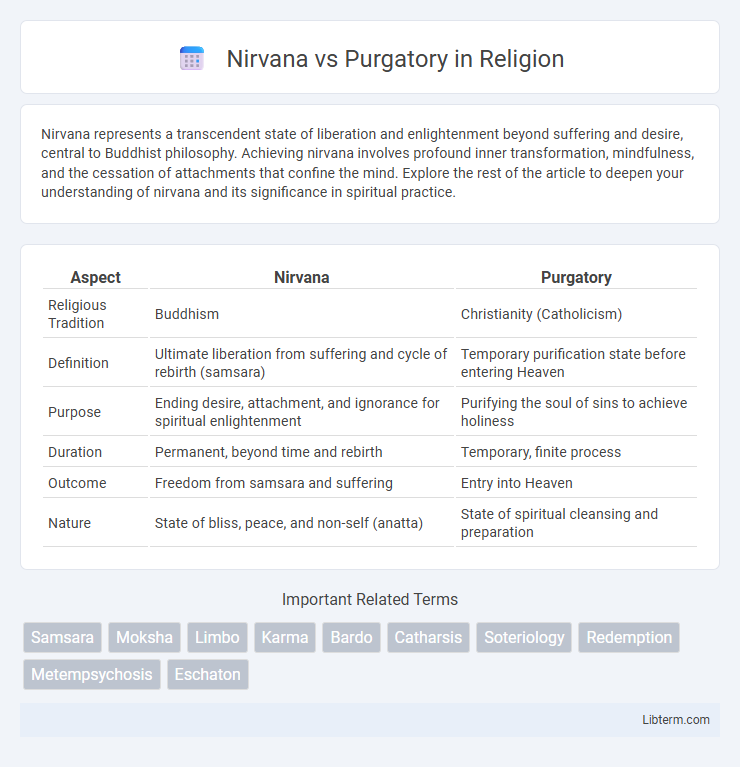Nirvana represents a transcendent state of liberation and enlightenment beyond suffering and desire, central to Buddhist philosophy. Achieving nirvana involves profound inner transformation, mindfulness, and the cessation of attachments that confine the mind. Explore the rest of the article to deepen your understanding of nirvana and its significance in spiritual practice.
Table of Comparison
| Aspect | Nirvana | Purgatory |
|---|---|---|
| Religious Tradition | Buddhism | Christianity (Catholicism) |
| Definition | Ultimate liberation from suffering and cycle of rebirth (samsara) | Temporary purification state before entering Heaven |
| Purpose | Ending desire, attachment, and ignorance for spiritual enlightenment | Purifying the soul of sins to achieve holiness |
| Duration | Permanent, beyond time and rebirth | Temporary, finite process |
| Outcome | Freedom from samsara and suffering | Entry into Heaven |
| Nature | State of bliss, peace, and non-self (anatta) | State of spiritual cleansing and preparation |
Introduction: Understanding Nirvana and Purgatory
Nirvana represents the ultimate liberation from the cycle of birth, death, and rebirth in Buddhist philosophy, embodying the cessation of suffering and the attainment of spiritual enlightenment. Purgatory, in Catholic doctrine, is a transient state where souls undergo purification to achieve the holiness necessary for entrance into heaven. Both concepts address the journey of the soul after death, emphasizing transformation and preparation for a higher state of existence.
Historical Origins of Nirvana
Nirvana, rooted in early Buddhist teachings from 5th century BCE India, represents the ultimate liberation from the cycle of birth, death, and rebirth (samsara). It is described as the extinguishing of desire, aversion, and ignorance, leading to freedom from suffering. Historical texts such as the Pali Canon detail Nirvana as a transcendent state beyond worldly existence, contrasting with purgatory's later Christian development as a temporal purification process.
Historical Origins of Purgatory
The historical origins of purgatory trace back to early Christian theology and practices, particularly evolving during the Middle Ages. Rooted in the belief of an intermediate state where souls undergo purification, purgatory has been influenced by Jewish concepts of the afterlife and early Church Fathers like St. Augustine. This doctrine was formally articulated by the Catholic Church in the councils of Lyon (1274) and Florence (1439), shaping its significance in medieval spirituality and contrasting with the Buddhist concept of Nirvana as ultimate liberation.
Core Beliefs: Eastern and Western Perspectives
Nirvana represents the ultimate liberation from the cycle of birth, death, and rebirth in Buddhist teachings, emphasizing the extinguishing of desire and suffering to attain spiritual enlightenment. Purgatory, rooted in Christian doctrine, particularly Catholicism, is viewed as a temporary state where souls undergo purification before entering heaven, highlighting the process of atonement and divine justice. These core beliefs reflect Eastern spirituality's focus on inner transcendence versus Western emphasis on moral cleansing and redemption.
Nirvana: The Path to Liberation
Nirvana represents the ultimate state of liberation in Buddhist philosophy, characterized by the cessation of suffering, desire, and the ego. This transcendent state is achieved through deep meditation, ethical living, and wisdom, leading to the extinguishing of the cycle of rebirth (samsara). Unlike purgatory, which involves temporary purification through suffering, Nirvana is permanent freedom from all forms of suffering and attachment.
Purgatory: The Realm of Purification
Purgatory serves as a transitional realm in Catholic theology where souls undergo purification to achieve the holiness necessary for entering Heaven. This process involves temporal punishment and cleansing from venial sins or remaining temporal punishment for forgiven sins, emphasizing God's mercy and justice. Unlike Nirvana's state of liberation from suffering and cycle of rebirth in Buddhism, Purgatory is temporary, aimed at spiritual refinement before reaching eternal salvation.
Comparative Religious Symbolism
Nirvana in Buddhism symbolizes the ultimate liberation from the cycle of birth, death, and rebirth, representing enlightenment and the cessation of suffering. Purgatory in Christian theology functions as a transitional state where souls undergo purification to achieve the holiness necessary for entry into heaven. Both concepts embody transformative processes in their respective religions, highlighting differing views on the afterlife, spiritual progression, and the purification of the soul.
Key Differences Between Nirvana and Purgatory
Nirvana represents the ultimate liberation from the cycle of birth and death in Buddhism, characterized by the cessation of suffering and desire, whereas Purgatory is a temporary state in Christian theology where souls undergo purification before entering heaven. Nirvana is a final, transcendental state achieved through spiritual enlightenment, while Purgatory is a transitional realm involving suffering aimed at moral cleansing. The key difference lies in Nirvana's eternal freedom from rebirth compared to Purgatory's role as a preparatory phase for the afterlife.
Cultural Impact and Interpretations
Nirvana and Purgatory have profoundly shaped cultural narratives surrounding the afterlife, with Nirvana often symbolizing ultimate liberation in Buddhist and Hindu traditions, influencing art, literature, and philosophy across Asia and the West. Purgatory, rooted in Catholic doctrine, has inspired countless works of medieval and Renaissance art, reflecting themes of purification and hope in Christian cultural contexts. Both concepts continue to inform global discussions on morality, spirituality, and existential purpose, highlighting their enduring relevance in contemporary religious and secular thought.
Modern Views on the Afterlife: Nirvana vs Purgatory
Modern views on the afterlife contrast Nirvana and Purgatory by highlighting Nirvana as a state of ultimate liberation from suffering and the cycle of rebirth in Buddhist philosophy, while Purgatory in Christian theology is seen as a temporary purification process before entering Heaven. Contemporary interpretations often emphasize Nirvana as an enlightened, transcendent state, accessible through meditation and moral living, whereas Purgatory is increasingly viewed as symbolic of spiritual cleansing and transformation. These perspectives reflect evolving cultural understandings of afterlife, morality, and spiritual progress.
Nirvana Infographic

 libterm.com
libterm.com